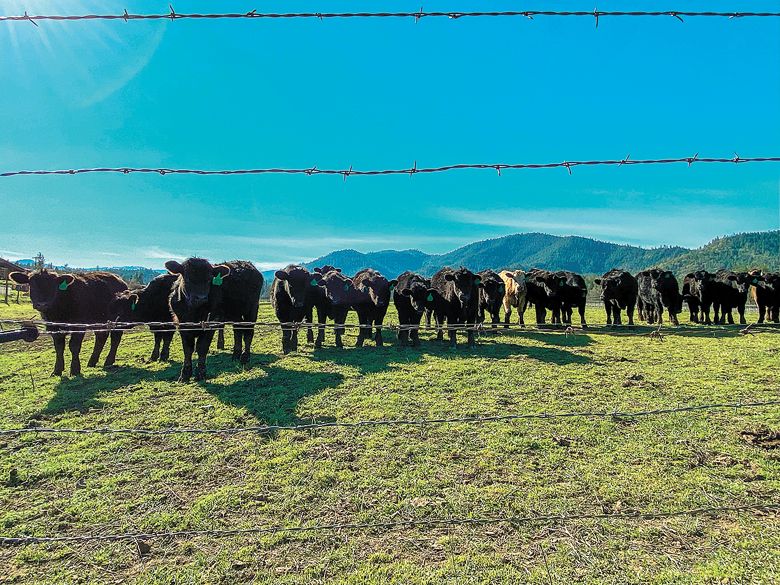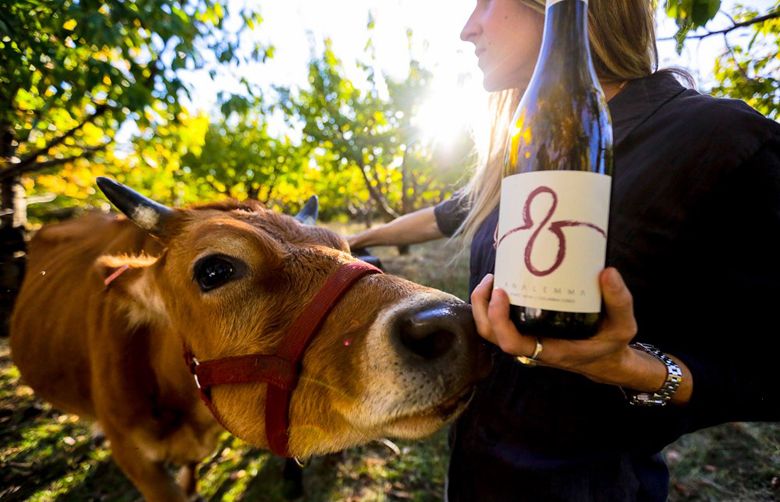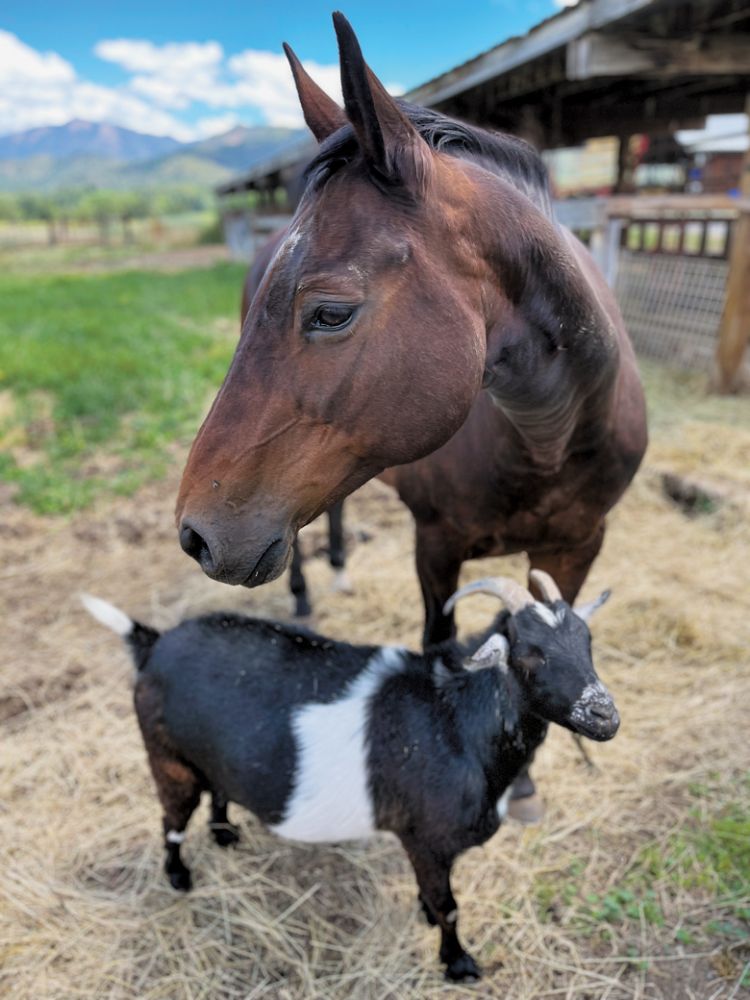Bovine and wine
Wineries enlist farm animals for a variety of reasons




By Michele Francisco
After months of being cooped up, I’m ready to enjoy the outdoors. Lately, I’ve been craving wine and farm animals. Not eating them, but rather observing critters while sipping a glass of wine.
Fortunately, that pastime is never very far away. Throughout Oregon, bucolic winery settings include occasions to watch and, sometimes, interact with animals that call these farms home. But don’t presume for a minute these creatures idle away their lives.
Goats and alpacas trim insistent blackberry bushes. Explains Taylor Pfaff, Left Coast Cellars Estate CEO, “The goats will eat almost anything and can be used in dense hotspots of invasive growth or in areas with complex terrain where we can’t implement mechanized solutions.”
Sheep, nature’s wooly lawn mowers, cut the cover crop and fertilize between vines. Cows do the same– along with converting fields of brush into grass pastures and providing fresh milk.
In their search for insects, pigs and chickens gently till and oxygenate the soil.
Pfaff says, “Last, but not least, our llama is the protector of the herd, ready to fend off the many predators on the estate that might want to turn our furry friends into a meal.”
Wineries expand biodiversity on their land with these animals. Soter Vineyards’ ranch manager, Joel Sokoloff says, “We raise animals at Mineral Springs Ranch to build liveliness and diversity beyond plants.” Developing well-balanced ecosystems benefits every aspect of the property. Healthier soils with higher microbial activity supply necessary nutrients for both the grapevines and the creatures enlisted to “work” among the rows.
Biodynamically-farmed Analemma Wines uses cows for a number of reasons. Co-founder Kris Fade shares, “Jersey cows are an essential element of farm life and what it means to us to be a Demeter-certified farm and winegrower. They deliver important nutrients to our soil and keep the grass down. Grounding us to place, these animals connect us to a greater meaning of what is living on our farm.”
“Just this spring we added sheep, goats and a llama to our farm family, says Pfaff. “We plan to actively utilize them in the vineyard as part of regenerative agriculture. For now, they help manage our oak savanna restoration project as well as play a lawn-mowing function in dormant vineyards during the winter.”
Farm animals also represent opportunities to inform and educate visitors. Fade explains, “Our cows serve as ambassadors of the biodynamic farming methods we use, especially on our Exploratory Field Tastings, when guests learn about how we farm while sipping wines on our estate.”
Left Coast is working to preserve its oak savannas; they expect the farm animals to help there, too. “We are seeking to establish indigenous trees, grasses and flowers that are vital for native wildlife. Invasive species like blackberry, hawthorn and Scotch broom are highly difficult to mitigate so we utilize seasonal livestock grazing to keep the understory clean and free of unwanted, invasive growth. Our many sheep handle the bulk of the grazing,” says Pfaff.
Some wineries require more than work from their livestock. They’re raising them to become meals… eventually. Sokoloff says, “We like to eat well and serve our guests meals prepared by our own hands and soil. The cattle and hogs add curiosity and joy, and their sorrowful farewells go hand-in-hand with what it means to raise stock and integrate them into the landscape. We love to watch the animals grow and deeply appreciate their gifts as they make the transition to our larder.”
Joe Ginet, rancher, winemaker and owner of Plaisance Ranch, shares his thoughts on raising livestock for food. “My wife, Suzi, and I are third-generation grape growers and ranchers who believe in good wine, good food and good soil. We raise cattle organically, as part of sustainable land management— plus having a steak and glass of wine grown side-by-side is pretty remarkable.”
“Cows help us realize the resourceful potential of our land, which is more than a monoculture of grapes. At Analemma, we subscribe to traditional agriculture where each organism is a web of animals, plants and humans, all working together to sustain the farm’s needs,” explains Fade.
Wineries must stay connected to the land. Plaisance Ranch’s Ginet continues, “By practicing regenerative farming and low-impact agriculture, we give back to our community and help the Applegate Valley ecosystem. Our acreage supports honeybee hives, heirloom vegetable gardens and orchards alongside grass-fed and finished beef. We grow grapes used in our 24 estate wines and appreciate our pets and natural wildlife. Horses are part of our family and help work the cattle. The donkeys are great with our customers, make loud watchdogs… and keep Suzi happy.”
If you want to visit a petting zoo, wine farms may not offer the best environment. Wineries are working spaces and their resident beasts might not enjoy visitors. Ask permission from the staff before interacting with any animals.
Where to find winery farm animals
While not comprehensive, this list will direct you to farm animals at wineries. Plan ahead; some businesses may require reservations.
Columbia Gorge
Driving through the Columbia River Gorge entails stunning cliffs, waterfalls and rock formations. I relish the chance to sip wine grown a stone’s throw from the river banks. Add some farm animals to the equation and, in my book, life is close to perfect.
Goats and cows: Hiyu Wines Farm
Cows: Analemma Wines
Northern Willamette Valley
Navigating the winding roads of the northern Willamette Valley promises pleasure around the next bend. Slightly more than an hour’s drive from Portland, wine lovers discover rural settings teeming with natural beauty. Pretend you are Dr. Dolittle for the day and talk with the animals at these wineries.
Longhorn cattle: WillaKenzie Estate
Sheep: Native Flora
Cows, sheep, pigs, donkeys and goats: Soter Vineyards
Pigs and goats: Beaux Frères Vineyard
Llamas: Rain Dance Vineyards
Pigs and alpacas: Abbey Road Farm
Southern Willamette Valley
Not far from Salem or Eugene, choose your own adventure, depending on your mood. Rolling hills, scenic vistas and farm animals enchant area visitors. Enjoying wine while viewing animals adding joy while lowering your stress level.
Sheep, goats and llama: Left Coast Cellars
Sheep, goats and pigs: Antiquum Farm
Pigs and sheep: Compton Family Wines
Horses: Illahe Vineyards and Winery
Rogue and Applegate Valleys
Traverse the Valleys outside Medford to find your farm animal fix. Appreciate the unique terroir and ecosystems. These wineries allow views of their animals as guests sip wine made from fruit grown mere feet away.
Sheep: Troon Vineyard
Alpacas: Rellik Winery
Cows, horses and donkeys: Plaisance Ranch










